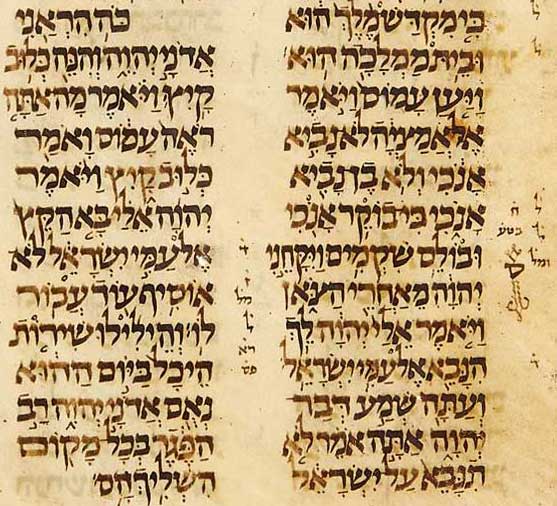Ever heard of the Masoretic Text? Know what it means? Know why it’s important?
The Masoretic Text is relevant to this series on Nehemiah because the introduction in my commentary on Nehemiah says “the Masoretic notes on EzraNehemiah were not placed after each book, but after Nehemiah, a proof that the Masoretes regarded EzraNehemiah as a unity.”
The Masoretic Text is also relevant because the introduction to most any modern translation of the Bible will include words such as these: “The ESV [English Standard Version] is based on the Masoretic Text of the Hebrew Bible as found in …”
So, what’s the Masoretic Text and why is it important?
First, the ‘first’ written record of every scripture found in the Bible has long been lost, as the recording was done on biodegradable matter like vegetation (papyrus reeds, river mud) and animal hides.
Second, the scriptures were copied repeatedly, and various changes crept in. Some changes were unintentional errors, for example missing a line or adding a word. Other changes were deliberate, for example replacing the name of God with something unpronounceable.
Third, the Old Testament portion of most modern Bibles is a translation of the Masoretic Text. (Unlike, for example, the “Great Bible” of 1539, Coverdale’s translation into English of the Latin Vulgate into English.)
Fourth, the Masoretic Text is the product of the first concerted effort, with many controls, to compare previous works and produce a standard or authorized version of every book in the Hebrew Bible.
Fifth, the Masoretic Text includes many notes which explain the decisions made by the scribes after comparing texts and interpretations.
Sixth, the Masoretic Text was produced by multiple scholars, over centuries, all of whom were committed to the project of being true to the received tradition.
The word ‘Masoretic’ is a derivate of ‘Masorete,’ derived from the Hebrew word masorah, which means ‘tradition.’ ‘Masorete’ is the name given to the people who, faithful to the traditions they honoured, produced the Masoretic Text, after centuries of labour.
There were Masoretes in Babylon (modern Iraq) and also Palestine. It is the work of the Palestinian Masoretes which has come down to us.
Aside from being verified and authorised, there are five other principal differences between Masoretic Texts and earlier texts.
The first is that the Masoretic Texts have marginal notes (masora). These notes serve various purposes, including openness about the decisions made and the controls used to detect and prevent transcription errors. For a good discussion, click here.
The second is that the Masoretic Texts have white spaces in the lines in texts to make the division (enunciation) of the text clear. For example, an earlier text may read “GODISNOWHERE,” while the Masoretic copy may read “GOD IS NOW HERE” (adapted from F F Bruce).
The third is that the Masoretic Texts have vowel marks – unlike English, Hebrew has only consonants, no vowels. The Masoretes devised and implemented a system of marks (niqqud) which serve as vowels.
The fourth is that the Masoretic Texts have marks (‘cantillation’) which indicate how words should be pronounced/chanted.
The fifth is that the Masoretic Texts have punctuation.
Why was it necessary to produce the Masoretic Texts?
I’ll use the words of Professor Donald L Brake to explain why the work of the Masoretes was necessary. This is from his book “A Visual History of the English Bible.”
“The final Jewish revolt against Rome in AD 135 signalled the beginning of the end of the Hebrew language. Most of the people forgot the language and what it sounded like. Sometime around AD 500 a group of Jewish scholars known as the Masoretes of Tiberius (a city in Galilee) began to preserve the Bible in the Hebrew language. The Masoretes flourished from AD 500 to 1000. They dedicated their lives to forming an intricate system to standardize and preserve the exact words of the biblical text. The oldest Hebrew Bible manuscripts we have today are the product of the faithful, meticulous copying of the Masoretes; we refer to these manuscripts as the Masoretic Text.”
It does not, however, follow that the Masoretic Text is always accepted in modern translations. There are occasions when another version, such as the Septuagint (Greek translation of the Old Testament which was used by the first Christians in debates with Jews) is preferred.
So, what’s the significance of the Masoretic Text for Nehemiah? According to the Masoretes, Ezra-Nehemiah is one book, not two. Knowing what you now know about the Masoretes, would you disagree with them? Why then do modern translations treat the two books separately?
Oh, and why do Christians rely so much on the work of Jewish scholars?
To learn more about Rama, click here.



Pingback: Why don’t we “use the Bible Jesus used?” - Bangsar Lutheran Church %